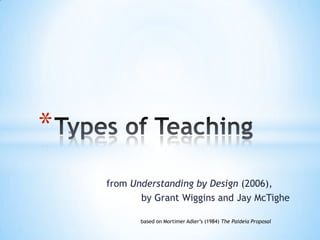
CBE5
- 1. from Understanding by Design (2006), by Grant Wiggins and Jay McTighe Types of Teaching based on Mortimer Adler’s (1984) The Paideia Proposal
- 2. revisualization I found Figure 10.2 (Wiggins and McTighe, 2006, p 241) incredibly useful, but I got lost going back and forth between “what the teacher uses” and “what the students need to do”
- 3. so I added color
- 7. tangent ahead
- 8. Wiggins and McTighe don’t, in fact, say anything about the use of color as a tool of design. they don’t say anything. really. I looked.
- 9. So I did some research.
- 10. attention span Color choices can also impact the teaching/learning process. Sinofsky and Knirck (1981) found that color influences student attitudes, behaviors and learning. In fact, they cited the most important reasons for using color effectively in learning environments. These reasons include that color affects a student's attention span and affects the student's and teacher's sense of time.
- 11. reduce absenteeism Papadatos(1973) suggested that the proper use of color in schools can convert an atmosphere that is depressing and monotonous into one that is pleasing, exciting and stimulating. He concluded that such change in color schemes in schools would reduce absenteeism and promote positive feelings about schools.
- 12. physiological Bross and Jackson (1981) declared that colors liked by students influenced their muscular tension and motor control (Poyser, 1983). Wohlfarth(1986) and Sydoriak (1987) associated warm colors with slight elevations in blood pressure in children while cooler colors caused slight drops in blood pressure (Hathaway, 1988). Likewise, Faily (1979) reported findings that optical stimulation by the use of warm colors and brilliance of lighting will cause increases in muscular tensions, respiration rate, heart action, blood pressure and brain activity. Cool colors and dim lighting bring about reverse effects such as muscles relaxing more and sleep being facilitated.
- 13. back to wiggins & mctighe
- 14. “To have taught well is not to have used a great set of techniques or given the learner some words to give back, but to have caused understanding through words, activities, tools, guided reflection, the learner’s efforts, and feedback” Wiggins & McTighe, 2006, p 228
- 15. color is a tool
- 16. Blackwell, H.R. (1963). A general quantitative method for evaluating the visual significance of reflected glare utilizing visual performance data. Illuminating Engineering, 58, 61. Bowers, J.H. & Burkett, G.W. (1987). Relationship of student achievement and characteristics in two selected school facility environmental settings. Edmonton, Alberta, Canada: 64th Annual International Conference of the Council of Educational Facility Planners. (ERIC Reproduction Service No. ED286278) Failey, A., Bursor, D.E., and Musemeche, R.A. (1979). The impact of color and lighting in schools. Council of Educational Facility Planners Journal, 16-18. Hathaway, W.E. (1994). Non-visual effects of classroom lighting on children. Educational Facility Planner, 32(3), 12-16. Hathaway, W.E. & Fielder, D.R. (1986). A window on the future: A view of education and educational facilities. Columbus, Ohio: Paper presented at the meeting of the Council of Educational Facility Planners. Hathaway, W.E. (1988). Educational facilities: Neutral with respect to learning and human performance. CEFPI Journal, 26(4), 8-12. King, J. & Marans, R.W. (1979). The physical environment and learning process. (Report No. 320-ST2). Ann Arbor: University of Michigan Architetural Research Laboratory. Papadotas, S.P. (1973). Color them motivated-color's psychological effects on students. National Association of Secondary School Principals Bulletin, 57(370), 92-94. Poyser, L.R. (1983). An examination of the classroom physical environment. South Bend: Indiana University. (ERIC Document Reproduction Services No. ED251954). Rice, A.H. (1953). Color: what research knows about color in the classroom. Nation's Schools, I-viii. Sinofsky, E.R. & Knirck, F.G. (1981). Choose the right color for your learning style. Instructional Innovator, 26(3), 17-19. Taylor, A. & Gousie, G. (1988). The ecology of learning environments for children. CEFPI Journal, 26(4), 23-28. from http://www.coe.uga.edu/sdpl/researchabstracts/visual.html
